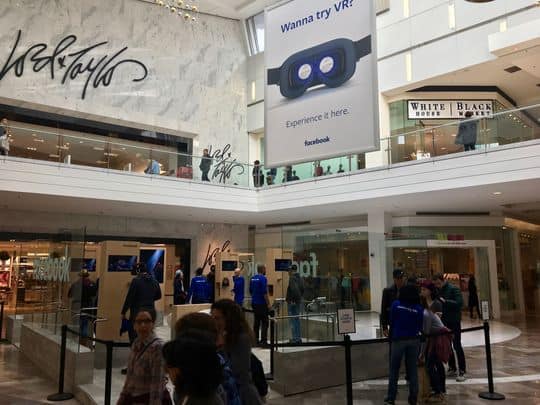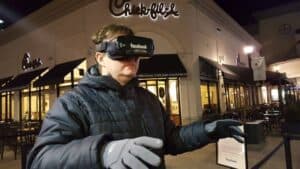A little known project surfaced this holiday season – Facebook VR Pop-up stores. Designed to give the public an introduction to virtual reality, the installations opened in shopping malls and airports over the past few weeks.
While 2016 has been a banner year for immersive technologies, the majority of the public has yet to try it. You can check the latest statistics in Haptical, from a Park Associates market study:
According to the study, half of consumers who try a virtual reality headset say, ‘they plan to purchase one’ and 15% make an ‘immediate decision to buy’ after experiencing the technology.
The study also reveals that more than 60% of U.S. broadband households know little or nothing about virtual reality.
Of course, not everyone will run out and buy an Oculus Rift after trying VR, but Facebook also has its partnership with Samsung in pushing Gear VR. And Facebook is looking longterm, hoping that its massive investment in social VR and the development of a mid-range VR headset will pay off.
One other note from the Park Associates study: 3.5 Million people now own a VR headset. Most of those were purchased during 2016. It’s an impressive start, but we still have a long ways to go.
Facebook VR Pop-up Stores

Here’s a description of the Facebook VR events in USA Today:
At the Denver International Airport display, a steady stream of travelers stopped in to test out the eight stations. Each guest gets a Facebook-assigned handler to walk them through the brief setup and then to make sure they don’t accidentally stumble or fall while undergoing the immersive experience.
Visitors watched a two-minute VR experience whisking them around the world and out beyond the stars, in a mix of real and computer-generated footage that includes basketball players, a short boat ride and getting plunked amid a circus.
Airport workers said that this was a revision of the original experience. Turns out that the original content was a little too realistic and “. . . a handful of viewers walked away dizzy.” Getting motion sickness before you fly is probably not a good idea.
Other issues were encountered – challenges we’ve pointed out before.
Guests face multiple warning signs about the risks of motion sickness, each kiosk has a safety grab rail, and workers to monitor users while they’re wearing the goggles and headset isolating them from the real world.
A thought experiment: imagine the introduction of the Smartphone requiring safety rails and staff to grab users before they fell down. Virtual Reality is taking off, but distributing an experience in a public setting is still very labor intensive (see our comments back in July in, Does VR Need a Hit?). Both the Sundance and Tribeca film festivals faced this challenge in rolling out VR film projects this year.
The pop-up stores will captivate a few new users, but it’s more a PR strategy. Seeing other people line up for virtual reality makes a statement. It’s an approach Snap has capitalized on in releasing its AR Spectacles.
Expect to see a lot more pop-up events and public demos of virtual reality in the coming year. And the number of VR headset owners will grow significantly with the release of mid-range VR headsets. 2016 wasn’t the year of VR, it was just the first step into a new era of visual experience.
Emory Craig is a writer, speaker, and consultant specializing in virtual reality (VR) and artificial intelligence (AI) with a rich background in art, new media, and higher education. A sought-after speaker at international conferences, he shares his unique insights on innovation and collaborates with universities, nonprofits, businesses, and international organizations to develop transformative initiatives in XR, AI, and digital ethics. Passionate about harnessing the potential of cutting-edge technologies, he explores the ethical ramifications of blending the real with the virtual, sparking meaningful conversations about the future of human experience in an increasingly interconnected world.

